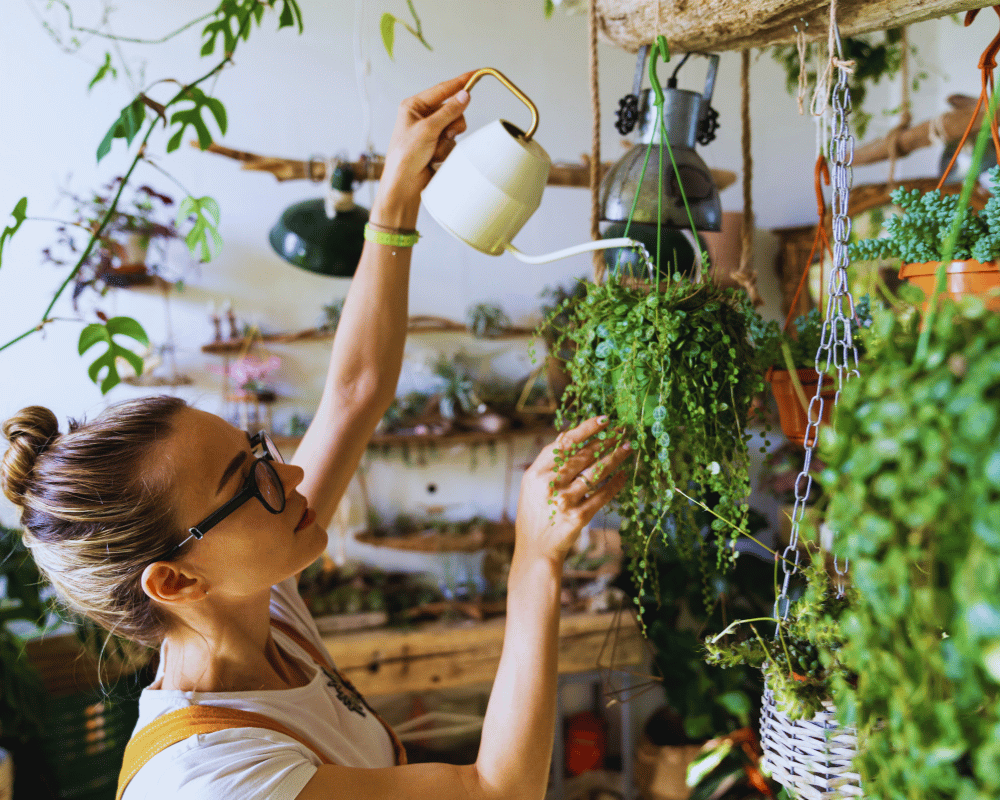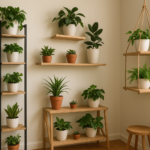Hanging plants add beauty, color, and life to your home or garden, but keeping them healthy requires proper watering. Unlike plants in the ground or on a shelf, hanging plants face unique challenges — their soil tends to dry out faster due to better air circulation, and water can easily drip down, causing a mess. If not watered correctly, these plants can quickly suffer from stress, leaf drop, or even die.
One key difference with hanging plants is their exposure. Elevated placement means they may get more sunlight, heat, and wind than plants at ground level, which accelerates evaporation. Because they’re often in smaller pots, their soil holds less moisture, making frequent checks important.
In this guide, we’ll walk you through everything you need to know about watering hanging plants — from choosing the right time of day to spotting early signs of overwatering or underwatering.
Understanding the Watering Needs of Hanging Plants
Hanging plants don’t have the same watering needs as ground plants, mainly because their containers hold less soil and dry out faster. How often you water depends on factors like the plant species, pot material, climate, and whether they’re indoors or outdoors.
Here are the main factors that affect watering needs:
- Plant type: Tropical plants like ferns or pothos need more frequent watering than succulents or cacti.
- Container material: Plastic pots retain moisture longer than clay or coconut fiber baskets.
- Location: Outdoor hanging plants exposed to wind and sun dry faster than those indoors.
- Climate: In hot, dry climates, watering might be needed daily; in cooler areas, every few days may be enough.
- Season: Plants often need more water during active growth in spring and summer compared to winter.
Choosing the Right Time of Day to Water

The timing of your watering can greatly influence plant health. Most gardeners recommend watering hanging plants in the early morning. This gives plants enough time to absorb moisture before the heat of the day causes evaporation. Morning watering also helps prepare them for exposure to sunlight, reducing stress and wilting.
Evening watering can work too, especially for indoor plants that aren’t exposed to intense sunlight. However, watering too late at night can leave soil damp for too long, potentially inviting fungal diseases or root rot.
Midday watering is generally not recommended for outdoor plants, as water can evaporate before it reaches the roots, and wet leaves may burn in strong sun.
If you live in a very hot climate, you might need to water both in the morning and lightly in the evening during summer.
Quick tips:
- Morning: Best for most plants, indoors or outdoors.
- Evening: Good for indoor plants or shaded outdoor areas.
- Avoid midday unless absolutely necessary during heatwaves.
Assessing Soil Moisture Levels Properly
Before you grab the watering can, you need to check whether your hanging plant needs water. The most common mistake plant owners make is watering without checking soil moisture first. Overwatering can be just as harmful as underwatering, leading to root rot, yellowing leaves, and plant decline.
Two simple ways to check soil moisture:
- Finger test – Stick your finger into the soil up to the second knuckle (about 2 inches deep). If the soil feels dry at that depth, it’s time to water. If it’s still moist, wait another day or two.
- Moisture meter – This handy tool gives a quick reading of soil moisture without guesswork. It’s especially useful for plants with deep root systems or dense soil.
Also, pay attention to soil color and weight. Dry soil tends to look lighter in color and feel less dense when you lift the pot.
Selecting the Right Watering Tools

The right tool makes watering hanging plants much easier and less messy. Because these plants are often positioned high up, a regular short-spout watering can might cause spills or strain your arms.
Best tools for the job:
- Long-spout watering cans – These let you direct water precisely to the soil without drenching the leaves or spilling.
- Self-watering globes – Great for people who travel or forget to water regularly. They slowly release moisture into the soil.
- Misters or spray bottles – Useful for increasing humidity around tropical hanging plants, especially ferns and orchids.
- Watering wands – Extendable tools that attach to a hose, perfect for outdoor hanging baskets.
Top Watering Techniques for Hanging Plants

Watering hanging plants isn’t just about pouring water into the soil — technique matters. If you water too quickly, it can rush through the pot and drain out before the roots absorb it.
Best techniques to try:
- Slow, steady watering: Pour water slowly until it begins to drain from the bottom. This ensures even moisture throughout the soil.
- Bottom watering: For smaller, easily removable pots, place them in a basin of water for 15–30 minutes. The soil will soak up water through the drainage holes.
- Double watering: In very dry soil, water once lightly, wait a few minutes, then water again. This helps the soil rehydrate evenly.
Avoid watering leaves directly unless your plant enjoys high humidity (like ferns). Constantly wet foliage can lead to fungal problems.
Preventing Water from Dripping Indoors
One of the biggest frustrations with indoor hanging plants is water dripping onto floors, furniture, or carpets. Thankfully, a few tricks can keep things clean while keeping your plants hydrated.
Solutions to prevent mess:
- Use saucers or drip trays: Place a tray beneath the pot inside the hanger to catch excess water.
- Add a plastic liner: Insert a plastic pot with drainage holes inside a decorative outer pot without holes. Remove it when watering and let it drain in the sink.
- Water over the sink or bathtub: Simply take the plant down, water thoroughly, and allow it to drain before rehanging.
- Use coconut coir or sphagnum moss liners: These help hold moisture and reduce runoff in wire hanging baskets.
Adjusting Watering Based on Plant Type
Not all hanging plants are created equal — and neither are their watering needs. Understanding your plant’s natural environment will guide you toward the right watering schedule.
Examples:
- Ferns & tropicals: Prefer consistently moist soil; water before the top layer fully dries.
- Succulents & cacti: Need less frequent watering; let the soil dry completely between waterings.
- Trailing plants like pothos or spider plants: Can handle short dry periods but still appreciate regular watering.
Also, consider root structure. Plants with fine, shallow roots dry out faster than those with thick, deep roots. If you’re unsure about your plant type, research its native habitat — desert plants thrive with minimal water, while rainforest plants love frequent moisture.
Matching your watering method to the plant type will not only prevent stress but also encourage better growth, vibrant leaves, and longer flowering seasons.
Signs of Overwatering in Hanging Plants
Overwatering is one of the most common mistakes when caring for hanging plants. It may seem like you’re helping, but too much water can suffocate roots and lead to serious plant health issues.
Signs to watch for:
- Yellowing leaves: Lower leaves turn yellow first as roots struggle to absorb nutrients.
- Root rot: If roots appear black, mushy, or smell foul, the plant is likely overwatered.
- Mold or fungus: White fuzz or mildew on the soil surface indicates excess moisture.
- Wilting despite wet soil: Ironically, overwatered plants can look droopy because roots are damaged.
Prevention tips:
- Always check soil moisture before watering.
- Ensure pots have proper drainage holes.
- Water slowly and allow soil to absorb moisture evenly.
If you notice early signs, reduce watering and let the soil dry out. Repotting into fresh, dry soil may be necessary for severe root rot. Think of overwatering like giving someone too much food — it may seem generous, but it can make them very sick!
Signs of Underwatering in Hanging Plants
Just as dangerous as overwatering, underwatering can quickly stress hanging plants. The most noticeable signs are often visual, but acting fast can save your plants.
Common signs:
- Drooping or curling leaves: Leaves lose turgor pressure and appear wilted.
- Dry, cracked soil: Soil pulls away from the pot edges and feels very dry to touch.
- Crispy leaf edges: Leaf tips brown and brittle due to lack of moisture.
- Slow growth or leaf drop: Plants may conserve energy by shedding leaves.
Recovery tips:
- Water the plant thoroughly, allowing excess water to drain.
- Mist the leaves for tropical plants to increase humidity.
- Avoid sudden heavy watering if the soil is extremely dry — water in stages to prevent shock.
The Role of Humidity in Hanging Plant Health
Humidity plays a huge role in keeping hanging plants happy, especially indoor tropical varieties. Dry air from heaters, fans, or air conditioning can make soil dry faster and stress your plants.
Ways to maintain proper humidity:
- Misting: Lightly mist leaves once or twice a day to mimic natural humidity.
- Humidity trays: Place a shallow tray filled with water and pebbles beneath the plant to evaporate moisture into the air.
- Grouping plants together: Clusters of plants create a mini-humid environment.
- Use a humidifier: Ideal for tropical plants during dry winter months.
Watering Outdoor vs. Indoor Hanging Plants
Outdoor and indoor hanging plants have different challenges that affect watering needs.
Outdoor plants:
- Exposed to sun, wind, and rain, which can dry soil quickly.
- May need more frequent watering in hot, dry weather.
- Water early in the day to prevent leaves from burning.
Indoor plants:
- Less exposed to evaporation but may suffer from dry indoor air.
- Can be watered slightly less frequently, but check soil regularly.
- Avoid overwatering, since indoor air doesn’t dry soil as fast as outdoors.
How to Water Hard-to-Reach Hanging Plants

High-hanging plants can be tricky to water safely. You don’t want to risk spilling water, damaging furniture, or injuring yourself.
Helpful techniques:
- Step stools or ladders: Make sure they’re stable and positioned correctly.
- Extendable watering tools: Long-spout cans or wands help you reach without stretching.
- Remove and water in sink: If safe, take the pot down, water thoroughly, let it drain, then rehang.
- Attach self-watering globes: For plants that are hard to reach often, this reduces frequent watering trips.
Seasonal Watering Adjustments
Watering needs change with the seasons. Plants grow actively in spring and summer and slow down during fall and winter.
Summer tips:
- Water more frequently due to heat and increased evaporation.
- Check soil daily in hot climates.
- Consider mulching with moss or bark to retain moisture.
Winter tips:
- Water less often since plants are dormant.
- Ensure soil doesn’t stay soggy to prevent root rot.
- Indoor heating may still dry out soil, so check moisture levels before watering.
Common Mistakes to Avoid
Even experienced gardeners sometimes make mistakes with hanging plants. Avoid these common errors:
- Watering on a fixed schedule: Check soil first — plants don’t follow calendars!
- Using cold water directly on roots: Cold water can shock plants; room temperature is best.
- Ignoring drainage: Always use pots with proper drainage holes to prevent root rot.
- Neglecting humidity: Tropical plants may need extra misting indoors.
- Overwatering indoor plants due to fear of drying out: Let soil dictate watering, not fear.
Conclusion
Watering hanging plants may seem challenging, but with the right approach, it’s straightforward and rewarding. By checking soil moisture, using the proper tools, adjusting techniques based on plant type, and observing environmental factors like humidity and season, your hanging plants will thrive beautifully. Remember, every plant is unique — treat each one like a living individual with its own needs.
FAQs
- How often should I water indoor hanging plants?
Check soil moisture before watering. Generally, indoor plants need water every 5–10 days depending on species and pot size. - What’s the best water temperature for plants?
Room temperature water is ideal. Avoid cold water that can shock roots, especially for tropical species. - Can I use tap water for all hanging plants?
Yes, but if your tap water is hard or heavily chlorinated, let it sit for a few hours to dissipate chemicals, or use filtered water. - Do hanging plants need fertilizer in water?
Occasionally, yes. Use a diluted liquid fertilizer every 2–4 weeks during active growth for lush foliage and blooms. - How can I keep water from dripping on my floor?
Use drip trays, plastic liners, or water plants over the sink to catch excess water before rehanging.







